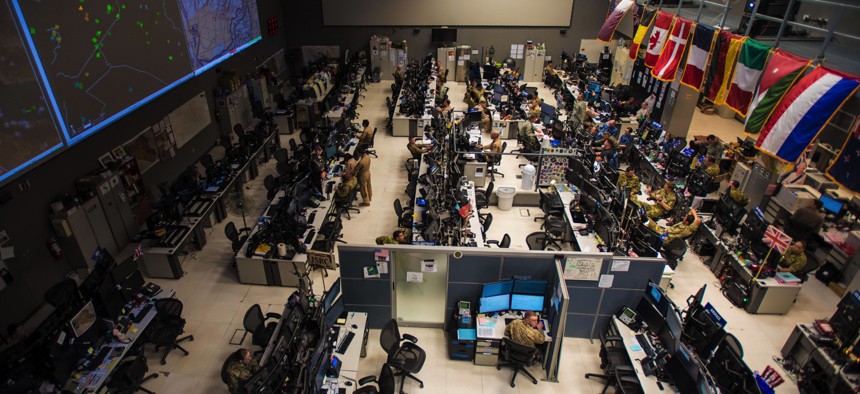
Combined Air Operations Center (CAOC) at Al Udeid Air Base, Qatar, provides command and control of air power throughout Iraq, Syria, Afghanistan, and other nations in the U.S. Air Forces Central Command region. U.S. Air Force / Staff Sgt. Alexander W. Riedel
How to Cut the US Presence in the Middle East
Asking the military to pursue the same goals with fewer resources will not work.
The new leadership in the Pentagon will be under a lot of pressure to reduce military commitments in the Middle East. Making cuts will not be enough, however. The Pentagon will need to relook its objectives and make strategic changes to force structure and basing.
The 2018 defense strategy, which called for major reductions in the region, offered hardly any guidance on how to do so. That is one reason tensions with Iran in 2019 and 2020 diverted aircraft carriers and fighter squadrons, knocking the strategy off balance. This did not have to happen, and it does not have to happen again.
The new administration’s defense strategy should lay out a deliberate approach to reducing U.S. commitments, starting with more modest goals for the military and a posture that is less forward-based and vulnerable. Asking the military to pursue the same goals with fewer resources will not work and may put U.S. forces at risk.
On Iran, cutting back could mean pulling away from forward defense of the Persian Gulf. Deterrence might rest on threats to respond through long-range strike at a time and place of U.S. choosing instead of blunting an early Iranian attack. Posture could shift to stand-off weaponry and a surge-oriented basing structure, using innovative concepts and capabilities being developed against China and Russia.
The new administration might cut back on asking the military to protect Gulf oil shipments, much of which go to China, and focus instead on motivating oil importing nations to shoulder the burden with American help. U.S. presence in the Gulf could go down to a spare element focused on coalition management and security cooperation, activities Iran is less likely to see as threatening and therefore worthy of provocation.
U.S. forces could still make Iran pay for any major oil disruption in the event of a conflict. Iran has long viewed closing the Strait of Hormuz as a kind of nuclear option. The world would quickly turn on Tehran were it to directly attack the world’s oil supply. Completely shutting off Iranian exports would be a legitimate response.
On counterterrorism, focus could narrow to imminent threats to the homeland. That might require pulling back from Afghanistan and focusing instead on holding the Taliban responsible for any attacks on the United States. Pakistan might become more helpful once U.S. forces are no longer in Afghanistan propping up a government hostile to Islamabad. Quiet cooperation from Pakistan’s long-armed military and intelligence forces could be enough to tamp down the threat from al Qaeda and ISIS, which operate mainly in the border areas.
The situation in Syria is more complicated. Accepting the sovereignty of the Assad regime and enabling the Russians and Iranians to pursue the shared danger of jihadist terrorism could help reduce the risk of an ISIS resurgence. The Biden administration’s concerns about human rights would be a challenge here. U.S. forces would still need access to the Levant. But a light footprint, if sustained and laser-focused on intelligence and by-with-through, could be enough to contain the threat long-term.
Iran-supported militias and weapons smuggling might be something for governments in the region to handle with American assistance. Fewer U.S. forces in the region might mean a less bellicose Iran and fewer targets for militias and small boats. There might be less risk of unwanted escalation and more incentive for Saudi Arabia and other regional powers to seek peaceful solutions and work together towards a common defense.
It’s too early to tell how feasible or acceptable any of these options might be, but if there’s going to be less of a role for the military, then something will have to give.
NEXT STORY: Urgent Job Opening: US Navy Secretary




